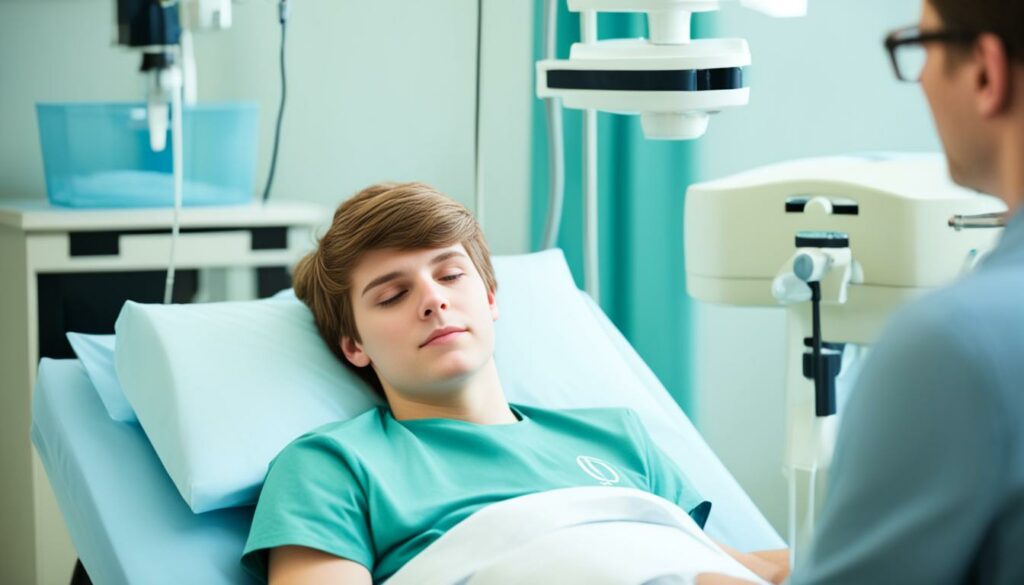Understanding Tics in Teens: Causes Explained
Tics, characterized by fast, repetitive muscle movements or vocal sounds, are fairly common in childhood and often first appear around the age of 5. While most tics are not serious and tend to improve over time, they can be frustrating and interfere with everyday activities. Tourette’s syndrome is a term used for tics that persist for more than a year. Tics can be triggered by various factors such as stress, anxiety, tiredness, excitement, or happiness. They can also be associated with other conditions like ADHD and OCD.
Treatment options for tics include self-help tips, therapies to reduce tic frequency, and medications. It’s important to note that tics generally improve over time or may stop completely.
Key Takeaways:
- Tics are fast, repetitive muscle movements or vocal sounds that typically first appear in childhood.
- Tics can be triggered by stress, anxiety, tiredness, excitement, or happiness.
- Tourette’s syndrome is a term used for tics that persist for more than a year.
- Tics can be associated with other conditions such as ADHD and OCD.
- Treatment options for tics include self-help tips, therapies, and medications.
Types of Tics in Teens: Motor and Vocal Movements

Tics in teenagers can manifest as either motor tics or vocal tics. Motor tics involve repetitive body movements, such as blinking, head jerking, finger clicking, or touching objects or people. These physical actions characterize motor tics and are commonly observed in teens with tic disorders.
Vocal tics, on the other hand, result in various sounds or phrases. These can range from coughing, grunting, sniffing, to repeating a specific sound or phrase. It is important to note that vocal tics can also include the use of obscene or offensive language in some cases, although this is less common.
“My son has motor tics like eye blinking and vocal tics such as throat clearing. It can be quite challenging for him, especially in social situations. But we’re learning to manage and support him through it.” – Parent of a teenager with tics
The specific movements or sounds associated with tics can vary between individuals, making each case unique. Some teenagers may have a combination of motor and vocal tics, while others may experience predominantly one type. The severity and frequency of tics can also differ, ranging from mild to more pronounced manifestations.
Understanding the different types of tics in adolescence is key to recognizing and providing appropriate support to teenagers affected by these involuntary movements and sounds.
“It was a relief when we finally got a diagnosis for my daughter’s tics. Now that we understand more about motor and vocal tics, we can better address her needs and help her navigate through her teenage years.” – Parent of a teenager with tics
Having a visual representation of the motor and vocal tic movements can help further illustrate their nature and impact on teenagers. The image above provides a clear depiction of these types of tics, providing a valuable reference for understanding and identification.
When to Seek Medical Help for Teenage Tics
Tics in teenagers are typically not cause for immediate concern and do not cause brain damage. However, there are certain situations where it is important to consult a medical professional for further evaluation and guidance.
If you notice the following signs or symptoms in your teenager, it is recommended to seek medical advice:
- The tics occur very regularly
- The tics become more frequent or severe
- The tics cause emotional or social problems
- The tics result in pain or discomfort
- The tics interfere with daily activities or school
- The tics are accompanied by anger, depression, or self-harm
Consulting a doctor can help in diagnosing tics and determining the appropriate course of action. The doctor may ask for a detailed description of the tic episodes or request a video recording to better understand the nature and frequency of the tics.
“In some cases, it may be challenging for teenagers to differentiate between normal tics and signs of a more serious underlying issue. Seeking medical help can provide reassurance and proper guidance.”
The doctor may recommend certain treatments or interventions based on the severity and impact of the tics. They can also address any concerns or questions you may have about your teenager’s tic symptoms.
Remember, it is always better to consult a medical professional if you have any doubts or concerns regarding your teenager’s tics. They can provide the necessary support and guidance to ensure the well-being of your teenager.
Treatment Options for Teenagers with Tics

Treatment for tics in teens can vary depending on the severity and impact of the symptoms. While mild tics that do not significantly interfere with daily activities may not require treatment, there are various options available for reducing tic frequency and managing tic-related challenges.
Self-Help Tips: In many cases, teens can benefit from implementing self-help strategies to manage their tics. By learning to effectively manage stress and fatigue, individuals can often experience a reduction in tic frequency. Engaging in regular physical exercise, practicing relaxation techniques, and getting enough restful sleep can all contribute to better tic management.
Therapies: For more severe tics that impact daily activities and social functioning, therapeutic interventions may be recommended. Three effective therapies for reducing tic frequency in adolescents are:
- Habit Reversal Therapy (HRT): This therapy involves identifying the specific tics and teaching teens to replace them with alternative movements or behaviors. By increasing awareness of tic triggers and implementing behavioral techniques, such as competing responses, teens can gain better control over their tics.
- Comprehensive Behavioral Intervention for Tics (CBiT): CBiT is a structured therapeutic approach that combines various techniques, including psychoeducation, relaxation training, and social support. This comprehensive intervention aims to reduce tic frequency and enhance quality of life.
- Exposure with Response Prevention (ERP): ERP is commonly used for treating tics associated with obsessive-compulsive disorder (OCD). The therapy involves gradually exposing teens to situations that trigger tics while refraining from engaging in the associated tic behavior. Over time, this can help reduce tic frequency and severity.
Medications: In some cases, medications may be prescribed to help reduce tics in adolescents. These medications can target the underlying neurological factors that contribute to tic development. Commonly prescribed medications for tics in teens include:
- Alpha-2 adrenergic agonists: These medications, such as clonidine and guanfacine, can help reduce tics by affecting certain neurotransmitters in the brain.
- Antipsychotics: Certain antipsychotic medications, such as risperidone and aripiprazole, may be prescribed to manage severe tics that significantly impact daily functioning. These medications are known to modulate dopamine levels in the brain.
- Botulinum toxin injections: In cases where motor tics are particularly problematic, injections of botulinum toxin can be used to temporarily weaken the affected muscles and reduce tic movements.
It’s important to note that medication is not always necessary for treating tics and should be considered in conjunction with other therapies and interventions. The choice of treatment will depend on the individual’s specific needs and the recommendations of healthcare professionals.
| Treatment Options | Description |
|---|---|
| Habit Reversal Therapy (HRT) | Aims to replace tics with alternative movements or behaviors through increased awareness and behavioral techniques. |
| Comprehensive Behavioral Intervention for Tics (CBiT) | Structured therapy combining education, relaxation training, and social support to reduce tic frequency. |
| Exposure with Response Prevention (ERP) | Gradual exposure to tic triggers while refraining from engaging in associated tic behaviors. |
| Alpha-2 adrenergic agonists | Medications that affect neurotransmitters to help reduce tics. |
| Antipsychotics | Medications that modulate dopamine levels in the brain to manage severe tics. |
| Botulinum toxin injections | Injections to temporarily weaken muscles and reduce tic movements, particularly in motor tics. |
Duration and Natural Progression of Tics in Teens

Tics can vary in duration and natural progression among teenagers. Fortunately, in most cases, tics tend to improve over time or may even stop completely. The exact duration of tics can vary from person to person, ranging from a few months to several years. During this time, tics may come and go, wax and wane, or change in their severity.
Typically, tics are most severe during early adolescence, usually around 8 years of age, and tend to improve as teenagers transition into puberty. This natural progression aligns with the hormonal changes and neurological development that occurs during this period of life.
The long-term outlook for teenage tics is generally positive. The majority of individuals with tics in adolescence experience a lessening of tic symptoms over time. It is not uncommon for some tics to persist into adulthood, but in general, they tend to become less severe and less frequent as individuals mature.
Understanding the duration and natural progression of tics in teens can provide reassurance both for teenagers experiencing tics and their families. It is essential to remember that each person’s tic journey is unique, and proper support and management can greatly contribute to a positive outcome.
Real-Life Experience:
“Having experienced tics as a teenager myself, I can attest to the natural progression and improvement that occurs over time. While my tics were quite noticeable during early adolescence, they gradually diminished as I entered my late teens. Today, they are barely noticeable, if present at all. So, for teenagers with tics, take heart – there is hope for a brighter, tic-free future!”
Causes of Tics in Teens: Neurological Factors and Genetics
The underlying causes of tics in teens are not yet fully understood. However, research suggests that tics are related to changes in the parts of the brain responsible for controlling movement. The exact mechanisms and triggers for tics remain unknown, but studies indicate that a combination of genetic and environmental factors contribute to tic development in adolescents.
Genetic influences play a significant role in tics, as tics have been observed to run in families. Certain genes are believed to be involved in tic disorders, although the specific genes and their functions are still being investigated.
Tics often co-occur with other conditions like Attention Deficit Hyperactivity Disorder (ADHD) and Obsessive-Compulsive Disorder (OCD). This suggests that there may be shared underlying neurological factors contributing to the development of tics and these other conditions.
“The exact causes of tics in teens are not fully understood. They are believed to be related to changes in the parts of the brain that control movement.”
Through ongoing research, scientists aim to uncover further insights into the neurological factors and genetic influences that contribute to tics in teens. By understanding these underlying causes, healthcare professionals can better diagnose and manage tic disorders in adolescents, improving the quality of life for those affected.
Environmental Factors and Triggers for Teenage Tics
Tics in teenagers can be influenced by a variety of environmental factors. These factors can trigger or exacerbate tic episodes, making them more frequent or severe. It’s important to understand these triggers to effectively manage tic symptoms in teenagers.
Stress and Tic Episodes
Stress is a significant environmental trigger for teenage tics. When teenagers experience stress, whether it’s related to school, relationships, or other sources, their tics may worsen. Stress can be caused by academic pressure, conflicts, or even personal challenges. Managing and reducing stress levels can help minimize tic episodes in teenagers.
Hormonal Factors and Tics
During adolescence, teenagers undergo significant hormonal changes. These hormonal fluctuations can contribute to the onset or worsening of tics. Research suggests that hormonal factors, particularly related to puberty, may influence the severity and frequency of tics in teens. Understanding the role of hormones is important when addressing and managing tic symptoms in this age group.
Other Environmental Triggers
In addition to stress and hormonal factors, other environmental triggers can affect teenage tics. Anxiety, tiredness, excitement, and even happiness can contribute to tic episodes. It’s important to recognize these triggers and help teenagers develop coping mechanisms to minimize their impact.
While environmental factors can influence tics, it’s crucial to note that they are not the sole cause of tic disorders. Individual susceptibility to tics varies, and a combination of genetic and neurological factors also play a role. Understanding the interplay between environmental triggers and underlying causes is key to providing effective support and management for teenagers with tics.
Links Between Tics and Other Conditions in Teens
Tics in teens are often associated with other conditions such as ADHD and OCD. Many individuals with tics also have a diagnosis of ADHD, OCD, or both. While the exact relationship between these conditions is not fully understood, it is believed that there are shared underlying neurobiological factors.
Understanding the association between tics and ADHD/OCD in teens is crucial for healthcare professionals. By recognizing the presence of other conditions, they can evaluate and treat tics in a comprehensive manner. Addressing comorbidities may help manage tic symptoms more effectively, improving the overall well-being of adolescents.
Tics in teens are often associated with other conditions such as ADHD and OCD.
Let’s take a closer look at the connection between tics and ADHD/OCD in teens:
Tics and ADHD
ADHD, or Attention-Deficit/Hyperactivity Disorder, is a neurodevelopmental disorder characterized by difficulties in attention, hyperactivity, and impulsivity. Research suggests that around 60-80% of individuals with Tourette’s syndrome (a term used for tics that have persisted for more than a year) also have a diagnosis of ADHD.
Both ADHD and tics share a common neural network dysfunction involving the frontostriatal circuits. These circuits play a crucial role in movement control and executive functions. The interaction between the two conditions may result from shared genetic and neurological factors.
Tics and OCD
OCD, or Obsessive-Compulsive Disorder, is a mental health disorder characterized by obsessions (intrusive thoughts) and compulsions (repetitive behaviors). Studies indicate that approximately 30-50% of individuals with Tourette’s syndrome also have a diagnosis of OCD.
The connection between tics and OCD is thought to be related to shared underlying neurobiological factors, including abnormal activity in the basal ganglia and orbitofrontal cortex. These brain regions are involved in motor control and the regulation of emotions and behaviors.
Relationship Between Tics, ADHD, and OCD in Teens
| Tics in Teens | ADHD in Teens | OCD in Teens |
|—————–|———————-|———————|
|Common occurrence|Frequent comorbidity |Significant overlap |
|Shared neurobiological factors involved|60-80% of individuals with Tourette’s syndrome have ADHD|30-50% of individuals with Tourette’s syndrome have OCD|
|Frontostriatal circuit dysfunction |Frontostriatal circuit dysfunction |Abnormal basal ganglia and orbitofrontal cortex activity|
In summary, tics in teens often coexist with conditions such as ADHD and OCD. The association between tics and these comorbidities may involve shared underlying neurobiological factors. By considering the presence of other conditions when evaluating and treating tics, healthcare professionals can provide more comprehensive care to adolescents affected by tics.
Conclusion
Tics in teens are a common phenomenon that is typically not serious and often improves over time or ceases completely. The underlying causes of these tics involve neurological factors, genetic influences, as well as environmental triggers like stress and hormonal changes. It is also important to note that tics can co-occur with other conditions such as ADHD and OCD, indicating a potential shared neurobiological basis.
Addressing the comorbidities associated with tics, such as ADHD and OCD, may prove beneficial in effectively managing tic symptoms in teens. Treatment options for tics include self-help strategies, therapies aimed at reducing tic frequency, and, if necessary, medications. By understanding the causes and factors contributing to tics in teenagers, healthcare professionals and families can provide better support and care for adolescents with these symptoms.
In conclusion, tics in teens are a manageable condition that can greatly improve over time. By employing a comprehensive approach that recognizes the neurological, genetic, and environmental influences on tics, healthcare professionals can help adolescents navigate these challenges and lead fulfilling lives.
FAQ
What are tics?
Tics are fast, repetitive muscle movements that can affect body movement or result in vocal sounds. They are fairly common in childhood and typically first appear around 5 years of age.
What are the types of tics in teens?
Tics can manifest as motor tics or vocal tics. Motor tics involve body movement, such as blinking, head jerking, or touching objects. Vocal tics result in sounds or phrases, ranging from coughing to repeating specific words or phrases.
When should I seek medical help for teenage tics?
It is recommended to consult a doctor if the tics occur very regularly, become more frequent or severe, cause emotional or social problems, result in pain or discomfort, or interfere with daily activities. A doctor can diagnose tics and recommend appropriate treatments.
What are the treatment options for teenagers with tics?
Treatment options for tics include self-help tips, therapies to reduce tic frequency, and medications. Self-help strategies may involve managing stress and fatigue, while therapy options may include habit reversal therapy and exposure with response prevention. Medications may be prescribed if necessary.
How long do tics in teens typically last?
Tics can last for a few months or come and go over several years. They are typically most severe in early adolescence, around 8 years of age, and tend to improve after puberty. The long-term outlook for teenage tics is generally positive, with tics becoming less severe and less frequent over time.
What causes tics in teens?
The exact causes of tics in teens are not fully understood, but they are believed to be related to changes in the parts of the brain that control movement. Tics can have a genetic component and often co-occur with other conditions like ADHD and OCD, suggesting shared underlying neurological factors.
What are the environmental triggers for teenage tics?
Environmental factors such as stress, anxiety, tiredness, excitement, and hormonal changes during adolescence can contribute to tic episodes in teenagers. However, it’s important to note that environmental triggers are not the sole cause of tics, and individual susceptibility to tics varies.
Are there links between tics and other conditions in teens?
Yes, tics in teens are often associated with other conditions such as ADHD and OCD. Many individuals with tics also have a diagnosis of ADHD, OCD, or both. Addressing these comorbidities may help manage tic symptoms more effectively.
What is the summary of causes and factors contributing to teenage tics?
Tics in teens can be caused by neurological factors and genetic influences. Additionally, environmental triggers, such as stress and hormonal changes, can contribute to tic episodes. Tics often co-occur with other conditions like ADHD and OCD.







